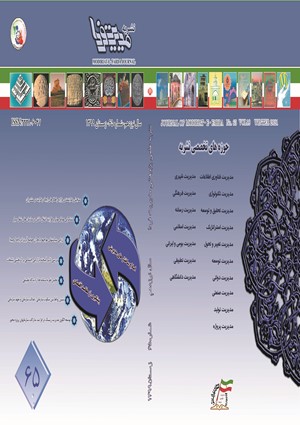Content analysis of ICT documents in order to deduce the policies of the Seventh Development Plan (approvals from 1998 to 2017)
Subject Areas :
Sahar Kousari
1
,
Fatemeh Saghafi
2
![]()
1 - Science Policy Department, National Research Institute for Science Policy
2 - Associate Prof. of University of Tehran
Keywords: Information and Communication Technology, Upstream Documents, Seventh Development plan, Content Analysis,
Abstract :
Five- year national development plans have a key role in achieving the goals of the vision document. There are two categories for development plan writing policies: diffusion-oriented and mission-oriented. So, prioritization in using an effective combination of the them is necessary. The purpose of this study is to determine the gap of upstream documents and propose policies to develop the seventh plan of ICT-sector. This research is descriptive-analytical in nature and it uses content analysis and documentary review. The population of resaerch are 67 meta-documents that have been selected as a purposeful and accessible sample for study. Analytical-descriptive method has been used to interpret and analyze the data. Based on the research findings, main policies were examined with a two-dimensional framework: 1) technological issues, which used the OECD classification, and 2) functional innovations, which presented in the 7-scale Hekkert classification. Then, the xial coding of each category was done in three levels of government, legislative and executive, and finally, based on the SWOT analysis of existing documents and its compliance with the claimed performance, principles were presented to develop the seventh ICT development plan. Accordingly, the program will have the necessary credibility if the central policies and principles proposed in the Seventh Development Plan of the ICT Sector will be valid.
آذري جهرمي،م. (1399). فرازهایی از برنامه مهندس آذری جهرمی جهت تصدی وزارت ارتباطات و فناوری اطلاعات،نشريه الكترونيك ترند، دانلود شده در 16/6/1399 از لينك https://tarand.ir/?p=2640
ابلاغ سیاستهای کلی «اقتصاد مقاومتي»؛ بارگذاري در 29/11/1392 و دانلود شده در16/6/1399از لينك: https://farsi.khamenei.ir/news-content?id=25370
شیدایی، منصور، علیدوستی، سیروس، نبی میبدی، مرتضی،(1398). چارچوب مفهومی موضوع¬های راهبردی فناوری اطلاعات (تحلیل اسناد راهبردی ملی و جهانی)، پژوهش¬نامه پردازش و مدیریت اطلاعات، دوره 34، شماره 3، صص 949-992
شقاقی، و. (1397). ارزیابی برنامههای پنجساله توسعه کشور ازمنظر تحقق اهداف اقتصادی سند چشمانداز. مجلس و راهبرد، شال 25 شماره 94، صفحه 209 الي 238.
قاضی نوری، سید سپهر، طرح پژوهشی آسیب¬شناسی وضعیت موجود اسناد سیاستگذاری ICT، مرکز تحقیقات سیاست علمی کشور، 1392، تهران، ایران.
قانون برنامه پنجساله ششم توسعه اقتصادی، اجتماعی و فرهنگی جمهوری اسلامی ایران (۱۴۰۰ـ ۱۳۹۶) بارگذاري شده در ستاريخ 16/1/1396 و دانلود شده در تاريخ 16/6/1399 از: https://rc.majlis.ir/fa/law/show/1014547
منتظر، غ.، (1390). طرح پژوهشی تحلیل اسناد فرادستی فناوری اطلاعات و ارتباطات، مرکز تحقیقات سیاست علمی کشور، 1390، تهران، ایران.
مصوبه جلسه سی و پنجم مورخ 20/09/1395 شورایعالی فضای مجازی دانلود شده در 16/6/1399 از http://majazi.ir//parameters/majazi/modules/cdk/upload/content/news/691/150614957242432o806lr5d3en85o13kc91rk60.pdf
گزارش دفتر خدمات دولت الكترونيك(1399). گزارش وضعیت دولت الکترونیکی در کشور، وزارت ارتباطات و فناوري اطلاعات ارائه شده در كميسيون شوراي عالي عتف، تیر 99
محقر و ديگران. (1398). پيش بيني الگوی تحول فناورانه در بخش خدمات مالي ايران بر مبناي رویکرد چندسطحی به گذار،فصلنامه سياست علم و فناوري، سال 11، شماره4، صفحه 77 تا 98.
نبوي و ديگران.(1396). شناسایی موانع و چالشهاي شکلگیری و توسعه نظام نوآوری در بخش هوانوردی عمومی ایران، فصلنامه مديريت فردا، سال 16، شماره 53 ، صفحه 297 تا312.
ناظمی اشنی، امیر، طرح تدوین سند فناوری اطلاعات و ارتباطات در کشور، مرکز تحقیقات سیاست علمی کشور، 1398، تهران، ایران
Carlsson, B. and R. Stankiewicz, On the nature, function and composition of technological systems. Journal of evolutionary economics, 1991. 1(2): p. 93-118
. Christopher, M. Weible, Sabatier, Paul, Jenkins-Smith, A, Hank C, Nohrstedt, Daniel, Douglas Henry, Adam and Deleon, Peter (2011) A Quarter Century of the AdvocacyCoalition Framework: An Introduction to the Special Issue, The Policy Studies Journal, Vol. 39, No. 3, 349-360
. Gal et al. (1994), methods of qualitative and quantitative analyze in psychology and education, translated in to Persian by Ahmad Reza Nasr and et al. (2007), Tehran, Shahid Beheshti university press
. Hekkert, M.P., Suurs, R., Kuhlmann, S. and Smits, R., 2007, “Functions of innovation systems: A new approach for analyzing technological change”, Technological Forecasting & Social Change, 74, pp. 413-432.
ITU (2017), Emerging ICT trends, ITU
Janda, K., L. Kristoufek, and D. Zilberman, Biofuels: Policies and impacts. 2012, Agricultural Economics, 58(8): p. 372-386.
Kessler, J., 2015, Assessing Low-Carbon Fuel Technology Innovation Through a Technology Innovation System Approach.
Miltiadis D. Lytras, Athanasia Pouloudi,2000, IT skills utilization: from rhetorical verbalism to applied knowledge management.
Negro, S.O., M.P. Hekkert, and R.E. Smits, 2008, Stimulating renewable energy technologies by innovation policy. Science and Public Policy, 35(6): p. 403-416
. OECD (2014). "Handbook on Constructing Composite Indicators: Methodology and User Guide" Tofigh, F. (2006). Planning in Iran and Its Future Prospect.
Vermaas, P., Kroes, P., van de Poel, I., Franssen, M., & Houkes, W. (2011). A philosophy of technology: from technical artefacts to sociotechnical systems. Synthesis Lectures on Engineers, Technology, and Society, 6(1), 1-134
. World Bank (2015). World Development Indicators Database.
Werle, R., (2012). Institutions and systems: analysing technical innovation processes from an institutional perspective. In Innovation Policy and Governance in High-Tech Industries (pp. 23-47). Springer, Berlin, Heidelberg.
Wendell, B., (2009). Foundations of Futures Studies: History, Purposes, Knowledge. Volume I: Human Science for a New Era, Transaction publishers


